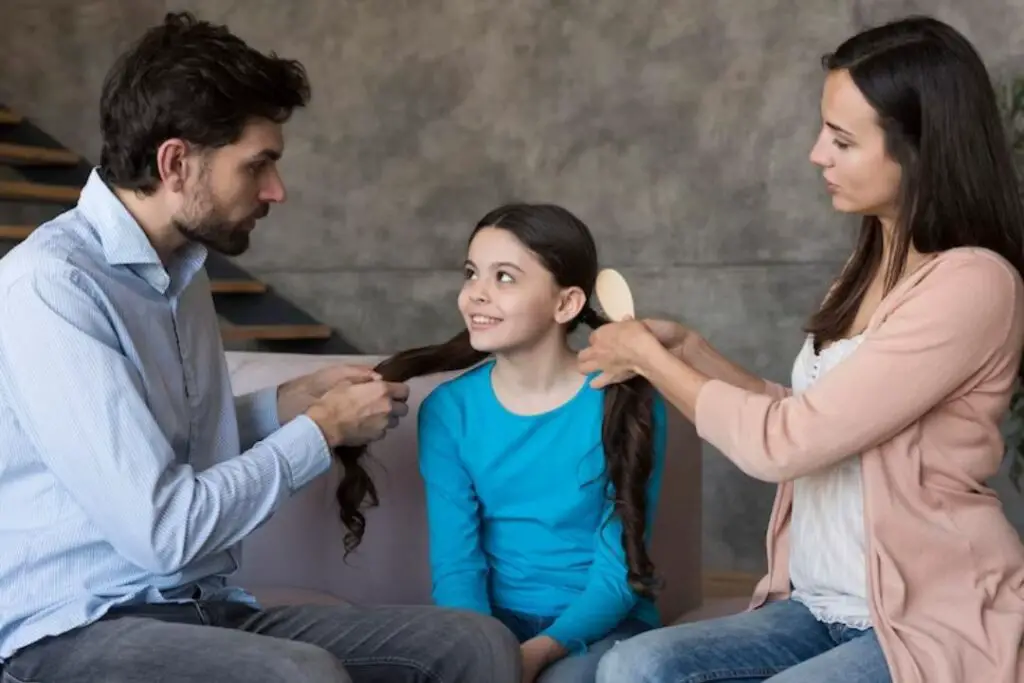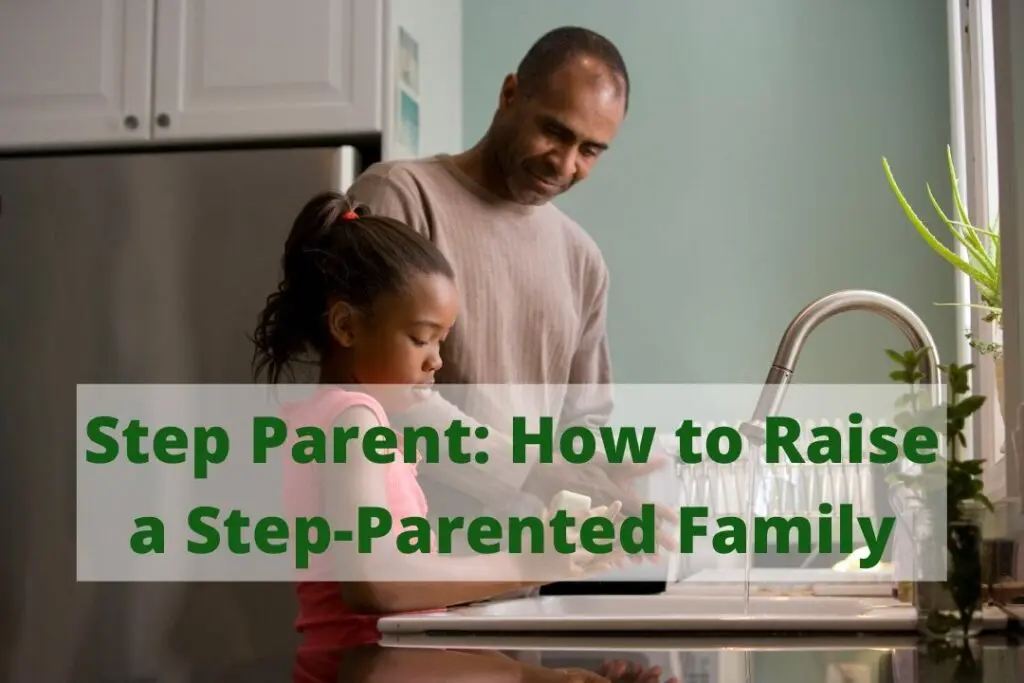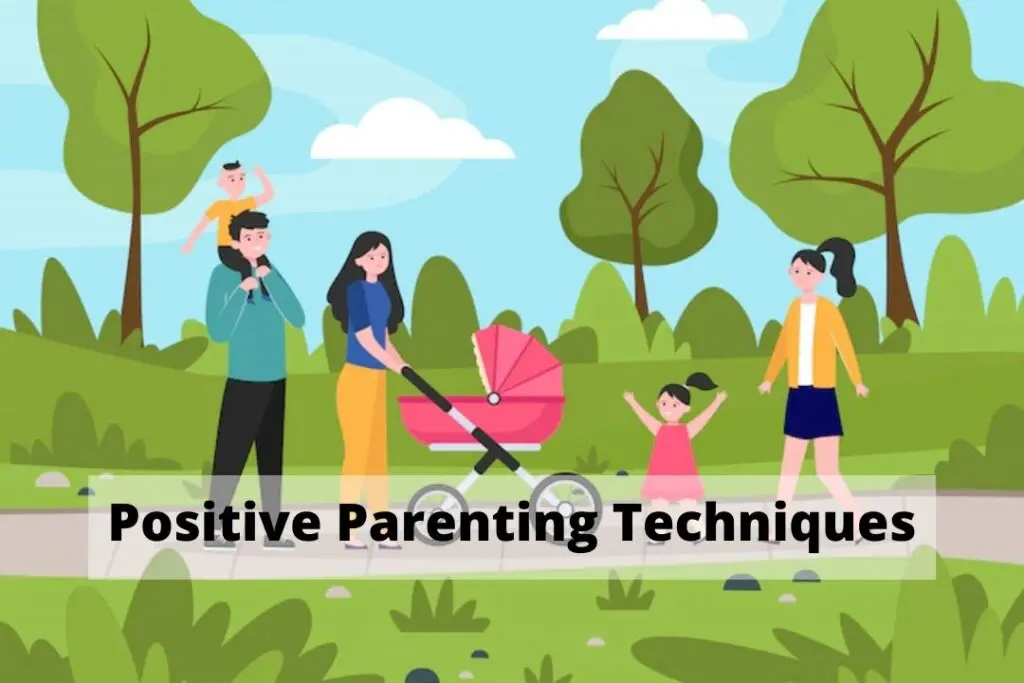Upon entering the bustling world of blended families, a myriad of questions and concerns often arise, one of them being the appropriate role of a stepparent when it comes to discipline. Imagine stepping into a lively household, the air filled with the warm scent of home-cooked meals, the soft hum of a television playing, and the echoing laughter of children. In this blog post you will learn about Should a Stepparent Discipline Their Partner’s Kids?
Suddenly, a vase shatters, a child cries, and the question surfaces – should the stepparent intervene?
The topic of discipline is not one to be taken lightly, especially in situations involving children who are not biologically yours. The concept of ‘correcting’ someone else’s child is a tightrope walk over a sea of potential misunderstandings, hurt feelings, and resentment. It’s a balancing act that requires delicacy, empathy, and a clear understanding of boundaries. Yet, despite the challenges, it’s an essential conversation for every blended family to navigate. The next words will explore in-depth this delicate issue with the goal of providing guidance and clarity.
Understand Your Role as a Stepparent
Should a Stepparent Discipline Their Partner’s Kids? Navigating the waters of stepparenthood requires careful balance. Start by respecting the biological parent’s authority, providing a basis of trust. Then, establish clear boundaries with the partner, preventing misunderstandings.
Take a step back to set appropriate expectations for oneself, ensuring personal sanity and happiness. In the face of disagreements, effective conflict resolution methods can be the glue holding the relationships together. Finally, establishing rules will provide consistent structure for the child, fostering a harmonious blended family.
Respect the Biological Parent’s Authority
Moving smoothly into the first sphere of your role as a stepparent, let’s delve into the realm of Respecting the Biological Parent’s Authority. As the sun has its place in the sky, so does the biological parent in a child’s life. It’s crucial to acknowledge this fact, accepting it with grace and understanding.
A garden flourishes best when it’s tended by a single gardener. Similarly, a child’s upbringing thrives under the influence of a single primary authority. Don’t attempt to usurp this role. Instead, remember that the biological parent has the right to make key decisions regarding their child.
Imagine stepping into a dance already in progress. The rhythm is established, the steps are set. It’s not your role to change the music, but to find a way to move harmoniously within it. This approach cultivates mutual respect, setting the stage for a balanced and flourishing stepfamily environment.
Establish Clear Boundaries with Your Partner
Imagine walking on a tightrope with your heart pounding against your chest. This is what it can feel like as a new stepparent, trying to find a balance between stepping into a parental role and respecting your partner’s established relationship with their children. Establishing clear boundaries with your partner becomes essential, a way of ensuring both your needs and their children’s needs are met.
Start with open conversations about how to approach parenting and discipline. Understanding the measures of each other’s comfort zone creates a mutual respect, which is vital for a harmonious household. Recognize and respect your partner’s unique parenting style, while also voicing your expectations.
Remember, this isn’t a sprint. It’s more of a marathon, requiring patience and perseverance. You’re not just building a relationship with your partner, but also creating a nurturing environment for the children. So, take a deep breath, step back and allow the love to unfold naturally.
Set Appropriate Expectations for Yourself
Dipping a toe into the waters of step-parenting? Embrace this journey by setting appropriate expectations for yourself. Remember, you’re not stepping into a superhero’s cape, but rather a loving, supportive role as a step-parent.
Imagine a step-parent as a gardener, not responsible for the seed but for nurturing the growth. Avoid the trap of perfection; it’s more important to be real and present. Understand that bonding might not happen instantly, it’s a process that requires patience and resilience.
Let’s face it, the world of step-parenting is laden with emotional landmines. Still, it should never be a competition with the biological parent. Remember to stay in your lane, offering love and support without crossing boundaries.
So, what’s the takeaway here? Go easy on yourself. Accept that there will be ups and downs. As a step-parent, your role is to create a safe, caring environment where a child can flourish. Allow yourself the grace to learn and grow along this journey.
Establish a Relationship with Your Stepchild
To Establish a Relationship with Your Stepchild, Take Time to Get to Know Each Other. Explore shared interests and create warm memories. Next, Communicate Openly and Honestly to foster trust. Show Respect to Your Stepchild through actions and words. An important aspect involves Understanding the Child’s Perspective, as it fosters empathy. Finally, Navigating Your Role as a Stepparent requires a delicate balance, ensuring love and guidance without overstepping boundaries.
Take Time to Get to Know Each Other
Transitioning from understanding your role as a stepparent, let’s now delve into building a connection with your stepchild. Imagine a garden, waiting to blossom. The seeds are there, but they need time, care, and attention to grow. Taking time to get to know each other is just like tending to this garden.
Every child is a unique flower with their own set of characteristics. Discovering these traits takes patience, curiosity, and lots of conversation. Explore their likes and dislikes, their dreams and fears. Engage in activities they enjoy, whether it’s playing a sport, painting, or reading a book.
Remember, this isn’t a one-day process. It’s like watching a flower bloom, petal by petal. Each day unveils something new, something beautiful about your stepchild. This phase of getting to know each other forms the foundation of a strong, loving relationship, full of mutual respect and understanding. So, take your time, and let the garden of your relationship flourish naturally.
Communicate Openly and Honestly
Having grasped the enormity of the role as a stepparent, let’s now turn the focus to strengthening the bond with the stepchild. In truth, the heart of any relationship lies in open and honest communication.
Picture this: a serene evening, two warm cups of cocoa, and a heart-to-heart conversation. Unveil the magic of open dialogue. Share about likes, dislikes, dreams, and fears. Listen attentively, respond gently. The key here is to create a safe space for expression.
Remember, honesty nurtures trust and, trust, in turn, strengthens relationships. Avoid sugar-coating truths or hiding concerns. It might be difficult initially, but the result is a sturdy foundation of trust and understanding.
Above all, exhibit patience. Open communication is a journey, not an instant achievement. Slowly but surely, one will see the beautiful transformation of a forced relationship into a cherished bond.
Show Respect to Your Stepchild
Now that the stage is set, let’s dive into the heart of the matter. Undeniably, the cornerstone of any relationship is respect. It’s no different when it comes to your bond with your stepchild.
Imagine a lush garden, where every bloom is treated with care and love; the result is a vibrant and thriving ecosystem. Similarly, when respect grows in the heart of your relationship, it blossoms into a beautiful bond.
Show genuine respect to your stepchild. Treat them as an individual with their own unique personality and interests. Acknowledge their feelings, and validate their opinions. Never belittle or dismiss their thoughts, no matter how trivial they may seem.
Remember, respect is a two-way street. By showing them respect, you’re not just teaching them how to respect others, but also setting the foundation for a strong relationship. After all, a garden nurtured with love and respect always blooms the most beautiful flowers.
Implement an Appropriate Discipline Strategy
When implementing an appropriate discipline strategy, open discussions with your partner form the cornerstone. Consistency and fairness, key elements to keep in mind, ensure the child doesn’t view punishment as arbitrary.
Shying away from physical punishments not only promotes a healthy environment but also teaches valuable lessons. The biological parent’s role needs careful consideration, laying the groundwork for effective discipline. Lastly, addressing resistance promptly and firmly helps foster understanding and compliance, making the disciplinary process smoother and more effective.
Discuss Discipline Strategies with Your Partner
Building on the established relationship with the stepchild, it’s essential to ensure that the discipline strategy aligns seamlessly with this connection. Kicking off this section, Discuss Discipline Strategies with Your Partner takes center stage.
Harmonious, open communication must exist when discussing discipline strategies. A serene atmosphere, bathed in the light of mutual respect, acts as the perfect backdrop for these critical conversations. It’s an environment where both partners can voice their opinions, fears, and hopes for the child’s discipline strategy.
The heart of these discussions lies in the alignment of expectations and the fostering of consistency. The frequency of these conversations should be akin to the gentle rhythm of a heartbeat – regular, reassuring, and necessary.
To avoid confusion and conflicting messages, a unified front is crucial. It is not about who is right or wrong but about finding a path that leads to the shared goal of raising a well-rounded, respectful, and responsible stepchild.
Be Consistent and Fair
And now, let’s move on from understanding the child to understanding discipline. In the world of step-parenting, consistency and fairness remain the cornerstones of effective discipline. Imagine, a carousel of predictability, where the rules never change, and fairness remains the constant thread.
Believe it or not, children find comfort in knowing the boundaries. It provides them a sense of security, and they know where they stand. Consistency, like the steady ticking of a grandfather clock, assures children that the rules apply equally, every day and in every situation.
On the other hand, fairness, softly glows like a lighthouse guiding a ship in the night. Children must see that all members of the family, whether biological or step, abide by the same rules. They must feel the warm embrace of equity, knowing that what is right for one is right for all.
In essence, consistency and fairness in discipline serve as the two loyal gatekeepers of trust in a blended family.
Avoid Physical Punishments
And now, let’s explore an essential aspect of setting disciplinary strategies: the avoidance of physical punishments. Spanking, slapping, or any form of physical punishment, tends to create fear rather than respect. It doesn’t just leave a mark on the child’s body, but also on their young heart and soul, leading to a potential emotional scar.
Not only is it crucial to avoid physical punishments, but also to replace them with positive reinforcement strategies. Try to emphasize the consequence of actions, explaining why certain behaviors are unacceptable. This approach encourages understanding rather than instilling fear.
Remember, communication is the key to a healthy relationship and discipline. It’s the golden bridge that connects hearts, even in times of conflict. In the end, the goal isn’t to control, but to guide and nurture. A stepchild, like any other child, needs love, understanding, and guidance – not fear.
Seek Support when Needed
In navigating the labyrinth of step-parenting, other stepparents provide a beacon of shared experience and wisdom. Unearthing gems of knowledge, professional resources offer indispensable guidance. Interwoven in the community fabric, community groups become stepping stones towards acceptance and understanding. The murky waters of conflicts with biological parents requires delicate negotiation, bringing the family closer. Finally, the shadows of feelings of inadequacy can be vanquished with uplifting reassurances.
Talk to Other Stepparents
And guess what? One is never alone on this journey of step-parenting. Talking to other stepparents provides an invaluable resource. They are the ones who have walked the path, battled similar demons, and emerged stronger.
In the gentle hum of their shared experiences, the tumultuous waves of uncertainty get calmer. From handling the prickly issues of discipline to navigating the turbulent waters of teenage rebellion, they’ve seen it all. Their seasoned insights illuminate the path like a beacon, guiding the way through the dense fog of parenting dilemmas.
Remember, it’s not just about seeking advice. It’s about finding camaraderie in shared struggles, relief in shared laughter, and strength in shared successes. So, take a moment, reach out and connect.
The wisdom of fellow stepparents is like a compass. It doesn’t decide the journey, but it certainly helps in charting the course. And that makes all the difference.
Utilize Professional Resources
Having already mastered the art of discipline, imagine having a treasure trove of professional resources at one’s disposal. Professionals like therapists, counselors, and social workers are not just for crisis situations. Routine check-ins with these experts can provide valuable insights and strategies.
Therapists are skilled in navigating complex family dynamics and can offer neutral ground for difficult conversations. They are a wealth of knowledge, able to offer evidence-based strategies for common stepfamily challenges.
Seeking the services of a counselor can help manage the emotional rollercoaster that often accompanies stepfamily life. They can provide tools to foster healthy communication and manage stress effectively.
Moreover, engaging with a social worker can open doors to a variety of resources. They can connect stepfamilies with community programs, support groups, and even financial assistance if needed.
Remember, harnessing these professional resources isn’t a sign of failure, rather it’s a bold step towards building a harmonious stepfamily.
Connect with Community Groups
Imagine a lively gathering, where laughter rings out and stories of shared experiences fill the air. Picture a warm, welcoming environment where everyone understands the struggles and joys of being a stepparent. That’s right,Community Groups offer a treasure trove of resources and support for those navigating the journey of step-parenting.
These groups, often formed by fellow stepparents, provide a safe space to vent, seek advice, and celebrate triumphs. In this nurturing environment, candid conversations replace judgment with empathy. Imagine the solace in knowing that others have walked the same path and have wisdom to share.
Moreover, these groups often organize events and workshops tailored to address common challenges that stepparents face. Visualize stepping into a seminar or a workshop, equipped with the knowledge that there are others who understand and advocate for the unique role of a stepparent.
Connect with Community Groups, they are a beacon of hope, a source of strength, and a wellspring of understanding in the journey of step-parenting.
Respond to Conflict in a Positive Manner
In responding to conflict, a positive approach is paramount. Modeling Positive Behavior sets the tone, fostering a harmonious environment. This then paves the way for Encouraging Open Communication, allowing for candid discussions and understanding. This is closely tied to Taking Time to Listen and Understand, demonstrating empathy and respect. This leads to Teaching Problem-Solving Skills, equipping individuals with tools to navigate and resolve conflicts. Finally, Promoting Positive Reinforcement underlines the benefits of handling conflicts positively, encouraging continued application of these strategies.
Model Positive Behavior
Moving on from seeking support when necessary, let’s glide into the realm of responding to conflicts in a positive manner. Now, imagine a canvas, filled with hues of understanding, compassion, and strength. That’s essentially the image Modeling Positive Behavior paints.
In this vibrant painting, the protagonist plays an inspiring role, setting an example for others to follow. Just like a lighthouse guiding ships in the middle of a stormy sea, positive behavior stands as a beacon of hope amidst conflict. It is a mirror reflecting values such as respect, empathy, and honesty.
With each stroke of this brush, one paints a picture of conflict resolution that is peaceful and constructive. It is a dance, a harmonious rhythm of actions and reactions that sets the stage for a positive environment. The artist, through their actions, inspires others to follow suit, thereby creating a masterpiece of a harmonious and peaceful atmosphere. This, my friends, is the power of Modeling Positive Behavior.
Encourage Open Communication
Transitioning from the essential need for support, a positive response to conflict requires fostering open lines of communication. Encourage Open Communication paints a vibrant picture of harmony and understanding. Imagine a canvas filled with vibrant colors, each representing a unique voice. Now, imagine these colors blending harmoniously, creating a beautiful masterpiece. This is the power of open communication.
A friendly environment, where each voice is heard and valued, sets the stage for this masterpiece. Fostering a culture of respect and understanding can make a huge difference. The courage to express thoughts and feelings without fear can be likened to the bold strokes of paint on a canvas. Encouraging this kind of expression can create an atmosphere of trust and mutual respect.
Finally, the masterpiece is completed with a clear understanding that everyone’s voice contributes to the overall beauty of the work. This metaphor illustrates how open communication, when encouraged and respected, can indeed create a harmonious environment.
Take Time to Listen and Understand
Sauntering from the comforting embrace of seeking support, we find ourselves in the bustling market of conflict resolution. Here, the rhythm of listening and understanding becomes the heartbeat of positive interaction.
Imagine a serene lake, reflecting the world in its calm depths. That’s the essence of listening and understanding: a tranquil reservoir of patience where everyone’s voice finds a mirror. It’s not just about hearing words, but about feeling the emotions behind them, about understanding the unspoken, about acknowledging the unsaid.
Listen with empathy, become that calm lake. Let the voices ripple across the surface, let every word sink deep. Because it’s not just about solving conflicts, it’s about understanding them, about learning from them.
Dive in, feel the undercurrents, the hidden meanings. Be patient, be understanding. Let the lake of empathy reflect everyone’s truth. And remember, in the bustling market of conflict resolution, understanding is the coin that never loses its value.
Reflect on Your Experiences
Reflecting on life’s experiences requires openness to acknowledge personal mistakes, followed by the heart-warming celebration of triumphs. The intricate dance of self-reflection also includes devoting moments for self-care, an essential rejuvenation tool. Further, it necessitates considering the influence from those significant figures in life – stepparents or stepchildren, and how they have shaped the journey. Lastly, personal convictions and attitudes towards discipline also play a part in this introspection, providing insights into the individual’s unique approach to life’s challenges.
Acknowledge Your Mistakes
Transitioning from a positive response to conflict, let’s bend the journey’s path towards introspection and growth. To paint a picture, think of it as a beautiful garden that thrives with nourishment, attention, and understanding.
In this garden of self-improvement, a significant seed to sow is the readiness to Acknowledge Your Mistakes. The petals of this flower may be tinged with the hues of regret and remorse, but it’s the stem, strong in its acceptance, that holds it upright. Each mistake is a stepping stone on the path of learning, a whispering wind of wisdom that stirs the leaves of experience.
Consider each error as a teacher, gracing life’s classroom with a lesson that promises growth and enlightenment. Acknowledging mistakes is not a symbol of failure, but rather a badge of courage. It’s the rain that nourishes the soul’s garden, the sun that shines on the path to personal development.
Celebrate Your Successes
Transitioning from conflict resolution, imagine this: an invisible trophy case, filled to the brim with small wins and monumental victories alike. That, dear reader, is the essence of celebrating successes.
Often overlooked, but so fundamentally vital, these celebrations punctuate the journey with bursts of joy and pride. Take notice of triumphs, both big and small. The first time a difficult conversation ends in understanding, not frustration. The moment a shared laugh replaces a shared tear. Each of these milestones deserves a moment in the spotlight.
Capture these moments with a celebratory ritual. Perhaps a quiet reflection over a hot cup of cocoa, or a boisterous family dinner filled with laughter and praise. The form matters not, only the recognition of achievement.
The journey may be long and sometimes rocky, but each success, each victory is a beacon of light illuminating the path ahead. So, let’s celebrate them, shall we?
Take Time for Self-Care
Pivoting from the stormy seas of conflict, imagine a serene island paradise, a place to rejuvenate and replenish. Known as self-care, this haven is not a luxury but a necessity.
Imagine the warm sunlight, a lovely metaphor for time spent in pursuit of personal interests and hobbies. It’s the fuel that recharges the weary soul, fostering a sense of fulfillment and joy.
Envision an inviting hammock, swaying gently in the breeze. This symbolizes the importance of rest and relaxation, essential for maintaining both physical health and mental resilience.
Picture a refreshing waterfall, mirroring the practice of mindfulness and meditation. It’s the oasis of calm, washing away stress and fostering a sense of inner peace.
Lastly, visualize a lush, vibrant garden, an emblem of nourishing one’s body with healthy food and exercise. It’s the foundation on which the structure of well-being and vitality is built.
Remember, self-care is not indulgence, but rather an investment in oneself.
Conclusion
In the end, embracing the role of a stepparent involves patience and understanding. It requires creating a bond with the stepchild, employing an appropriate discipline strategy, seeking help when needed, handling conflicts with positivity, and learning from the experiences.
The journey of a stepparent may be strewn with challenges, but it harbors potential for immense joy and fulfillment. Understanding and respect go a long way in creating a harmonious family environment. Always remember, every stepping stone encountered is an opportunity for growth and strengthening relationships.




